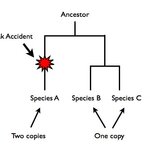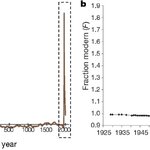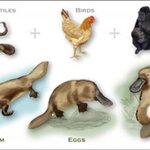Genetics & Molecular Biology

In biology, everything has a history. Creationists love to try to calculate the probability of a new gene spontaneously coming into existence, but that's not how genes are born. New genes most often come from other genes: one gene gets duplicated by a freak accident (like the accidental duplication of a chunk of chromosome, a whole chromosome, or even an entire genome), so that you suddenly have a cell with two working copies of the same gene. As time goes on (that is, time on an evolutionary scale), those two duplicate genes start to divide up the work that was originally done by just one…

Scientists have been trying to understand how and when we gain or lose fat cells, and now a paper in this week's issue of Nature reports that nuclear bombs are the key to solving this problem.
To understand how our bodies regulate our weight, researchers are interested in knowing how the number of fat cells changes over our lifetime - do we stop making more fat cells after adolescence? Do we keep the same fat cells all of our adult lives, or do some die off and get replaced by new ones? The typical way to study the birth and death of cells in live animals is to use radioactive tracers that…

Much of the coverage of autism in the media focuses on the arguments of advocates, scientists, and government officials over the relationship between vaccines and autism. But out of the spotlight, a bigger story is brewing: the hunt for autism genes, a technically difficult hunt which is pressing forward using all of the tools modern genetics has to offer. If you are like me, news stories about autism have left you with only a vague impression of the current scientific state of understanding, the impression that researchers strongly deny any link between autism and vaccines, but have little…

In 2001, the DNA sequence was published of a combination of persons. The DNA sequences of Jim Watson, discoverer of the DNA’s double helix structure, followed in 2007, and later the DNA of gene hunter Craig Venter. Recently the completion of the sequences of two Yoruba Africans was announced.
Now geneticists of Leiden University Medical Centre (LUMC) in The Netherlands have determined the first DNA sequence of a woman - and also the first European. This has been announced by the researchers this morning, during a special press conference at ‘Bessensap’, a yearly meeting of scientists and the…

A new study released today in the online edition of Physiological Genomics finds that individuals with a specific genetic variation consistently consume more sugary foods. The study offers the first evidence of the role that a variation in the GLUT2 gene – a gene that controls sugar entry into the cells – has on sugar intake, and may help explain individual preferences for foods high in sugar.
Summary of the Study
Food preferences are influenced by the environment as well as genetics. Cravings for foods high in sugar vary from person to person, but the reasons why are still unclear. To…

I haven't contributed a single thing to the platypus genome project, but since my desk sits one floor above where people and robots broke the platypus DNA into chunks, cloned those chunks into bacteria, sequenced the pieces of DNA, and used massive amounts of computing power to assemble the stretches of sequence into a complete genomic whole, I'm going to consider myself somewhat of an authority on the subject and tell you what's wrong with other people's ideas about the platypus.
The genome sequence of the platypus was published Thursday in Nature, and from the press headlines, you could be…
President Bush has a bill on his desk, the Genetic Information Nondiscrimination Act (GINA), which will prohibit discrimination on the basis of genetic information with respect to health insurance and employment. He is expected to sign the bill, but is science – and the people – ready?
The bipartisan bill, co-sponsored by Reps. Judy Biggert, R-Ill., and Louise Slaughter, D-N.Y., passed the Senate by a vote of 95-0 and the House, after agreeing to some adjustments by the Senate, passed the bill 414-1 (the lone nay? Rep. Ron Paul, R-Texas).
The bill opens with a nod to scientific…

An international study has discovered 10 new genes related to human growth.
This meta-analysis, published in the latest issue of Nature Genetics, is based on data from more than 26,000 study participants. It verifies two already known genes, but also discovered ten new genes. Altogether they explain a difference in body size of about 3.5 centimeters.
The analysis produced some biologically insightful findings. Several of the identified genes are targeted by the microRNA let-7, which affects the regulation of other genes. This connection was completely unknown until now. Several other SNPs may…

The first genome sequencing project of a mammal that lays eggs is complete and, like the animal itself, the DNA of the platypus is something of a patchwork.
The platypus, found in eastern Australia, including Tasmania, is one of the five species of mammals that lay eggs instead of giving birth to live young. The four species of echidna are the other mamimals that share this distinction.
The curious discovery of the duck-billed, egg-laying, otter-footed, beaver-tailed, venomous platypus in 1798, comfortable on land and in water, convinced British scientists that it must be a hoax. Sketches of…

A gut hormone that causes people to eat more does so by making food appear more desirable, suggests a new report in the May issue of Cell Metabolism. In a brain imaging study of individuals, the researchers found that reward centers respond more strongly to pictures of food in subjects who had received an infusion of the hormone known as ghrelin.
The findings suggest that the two drives for feeding — metabolic signals and pleasure signals — are actually intertwined.
“When you go to the supermarket hungry, every food looks better,” said Alain Dagher of the Montreal Neurological Institute at…